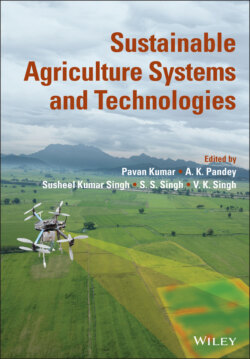Читать книгу Sustainable Agriculture Systems and Technologies - Группа авторов - Страница 36
2.7.1 Diversification with Oilseed Crops
ОглавлениеAt present, there are around 25 Mha area under oilseed crops with 37 MT of total production, even this is not sufficient to meet domestic oil requirement, hence India is importing around 15 MT of edible oils from abroad. On the other hand, there exists enormous potential to expand oilseeds area in the country and crop diversification with oilseed crops is one of such options. And it is hugely possible in irrigated IGP regions through crop intensification, where number of computable crops are grown either in sequential or intercropping systems. There are crops which act as complementary to each other when grown together, like growing legumes with cereals, through positive allopathic effect (mustard + wheat, mustard + potato, etc.) and in tier/multistoreyed system. This type of crop combination needs to be identified and promoted for achieving desired results. The selection of crops in crop diversification depends upon many factors like available resources, prevailing weather conditions, market demand, ease of doing cultivation, and overall high productivity and profitability from the possible combinations. The established possible combination is enlisted below (Tables 2.1 and 2.2).
Inclusion of oilseed crop, Indian mustard with early maturing short duration varieties like PM 28 and PM 26 in maize (fodder)‐mustard‐late wheat system restyled n higher system productivity and also the profitability (Table 2.3). Maximum system productivity (49.9 t/ha) and system net return (Rs. 1.45 lakhs) were obtained from M‐M(PM28)‐late wheat (HD 3118) Maize‐mustard (PM28)‐late wheat (HD 3118) system.
Table 2.1 Crop diversification options with oilseed crops.
Source: Modified from Palaniappan and Jeyabal 2002.
| Crop | Area suggested for diversification |
|---|---|
| Rapeseed‐mustard | The short duration, terminal heat resistant varieties like PM 25, PM 26, and PM 28 As a substitute of meager productive rainfed wheat In diaratract in northern and eastern India A very good intercrop has positive allopathic effect on associated crops. |
| Groundnut | The short duration varieties can be introduced in many low rainfall areas during kharif season and as summer crop in the areas of adequate irrigation facilities. As a substitute crop for minor millets in Bihar, Jharkhand, West Bengal, and Orissa Substitute rice–groundnut with rice–rice system to prevent buildup of pests and diseases |
| Soybean | As a replacement crop for low yielding upland rice, minor millets growing areas of in Bihar, Jharkhand, and Orissa As a complementary rotational crop in pest endemic areas of rainfed cotton. In nontraditional areas of North‐Eastern Hill sunder agripastoral or agri‐silvicultural Diverting some kharif cereal area to soybean in situations of water scarcity and to restore soil health in North India. |
| Sunflower | As are placement crop for low yielding wheat, cotton, chickpea, sorghum crops under black cotton soils in peninsular India. As a spring crop in Northern India after harvest of rabi season crops. |
| Sesame | The short duration cv are good for raising as kharif crops in many areas. Also as a summer crop in central peninsular and Eastern India where only limited irrigation is available. |
| Castor | This is a nonedible but commercially very important crop and can be grown as substitute crop of cotton in Rajasthan and as bund crop in all regions. |
Table 2.2 The diversification of traditional crop base with annual oilseed crop.
Source: Reddy and Suresh 2006.
| Prevailing crop | Suggested crop | Region |
|---|---|---|
| Rice fallow | Rapeseed‐mustard, soybean, and sesame | Eastern part of the country, Cauvery deltaic areas of Tamil Nadu and Coastal Andhra Pradesh |
| Upland rice | Groundnut (Kharif), soybean, and sunflower | Upland rice areas of Orissa, Tamil Nadu, Bihar, and A.P. |
| Cotton | Safflower and sunflower | Karnataka and adjoining areas of A.P. |
| Chickpea, dryland wheat, and coriander | Safflower (sole crop) | A.P. (rabi), Karnataka, Maharashtra, part of M.P. (Malwa region) |
| Linseed and barley | Safflower (sole crop) | South eastern Rajasthan (Udaipur) |
Table 2.3 System productivity and economics of maize‐based diversification system.
Source: Data from Rathore et al. 2020.
| Cropping systems | System productivity, kg/ha | WEY, kg/ha | Production efficiency, kg/ha/day | System NR, Rs./ha | System profitability, Rs./ha/day | SP | WEY |
|---|---|---|---|---|---|---|---|
| Maize‐wheat | 46556c | 9179d | 211.6a | 42.2a | 118027d | 536.4a | |
| Maize‐mustard (PM26)‐late wheat (HD 3118) | 48901b | 11834b | 168.6c | 50.6b | 137478b | 474.0c | |
| Maize‐mustard (PM28)‐late wheat (HD 3118) | 49922a | 12252a | 172.1b | 51.9b | 144996a | 499.9b | |
| Zn levels | |||||||
| Control | 44881.5c | 10332d | 166.5d | 46.4a | 117975d | 435.4d | |
| Zn 2.5 | 48810.8b | 10828c | 180.9c | 46.8ab | 126037c | 465.9c | |
| Zn 5.0 | 49570.4b | 11622b | 183.9b | 49.7b | 141019b | 520.5b |
System productivity of maize (fodder)‐early mustard (PM 28)‐late wheat (HD 3118) was recorded maximum with higher net return and B : C ratio. Similarly higher system productivity and profitability were recorded under 5.0 kg Zn application during kharif season crop in a calendar crop year.
